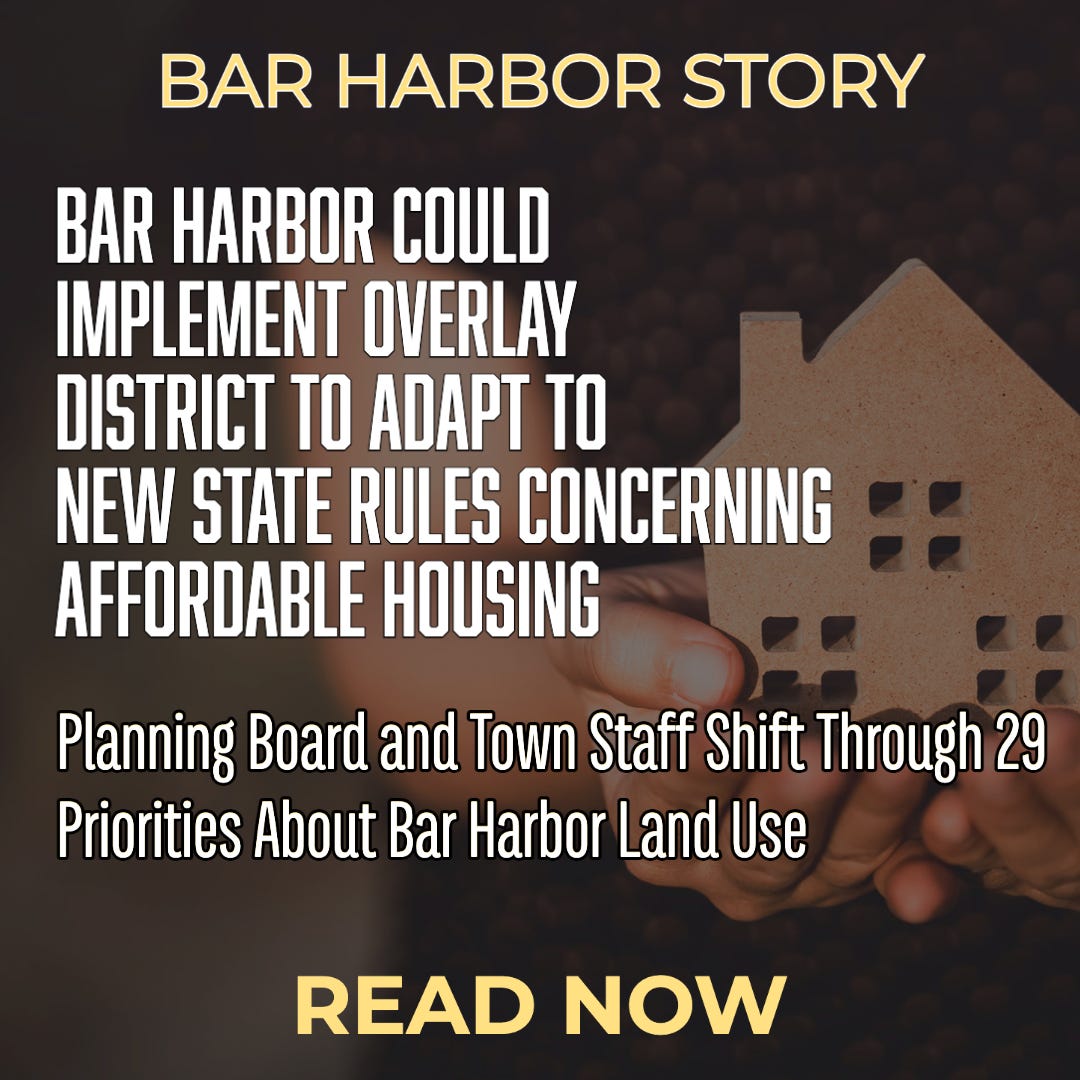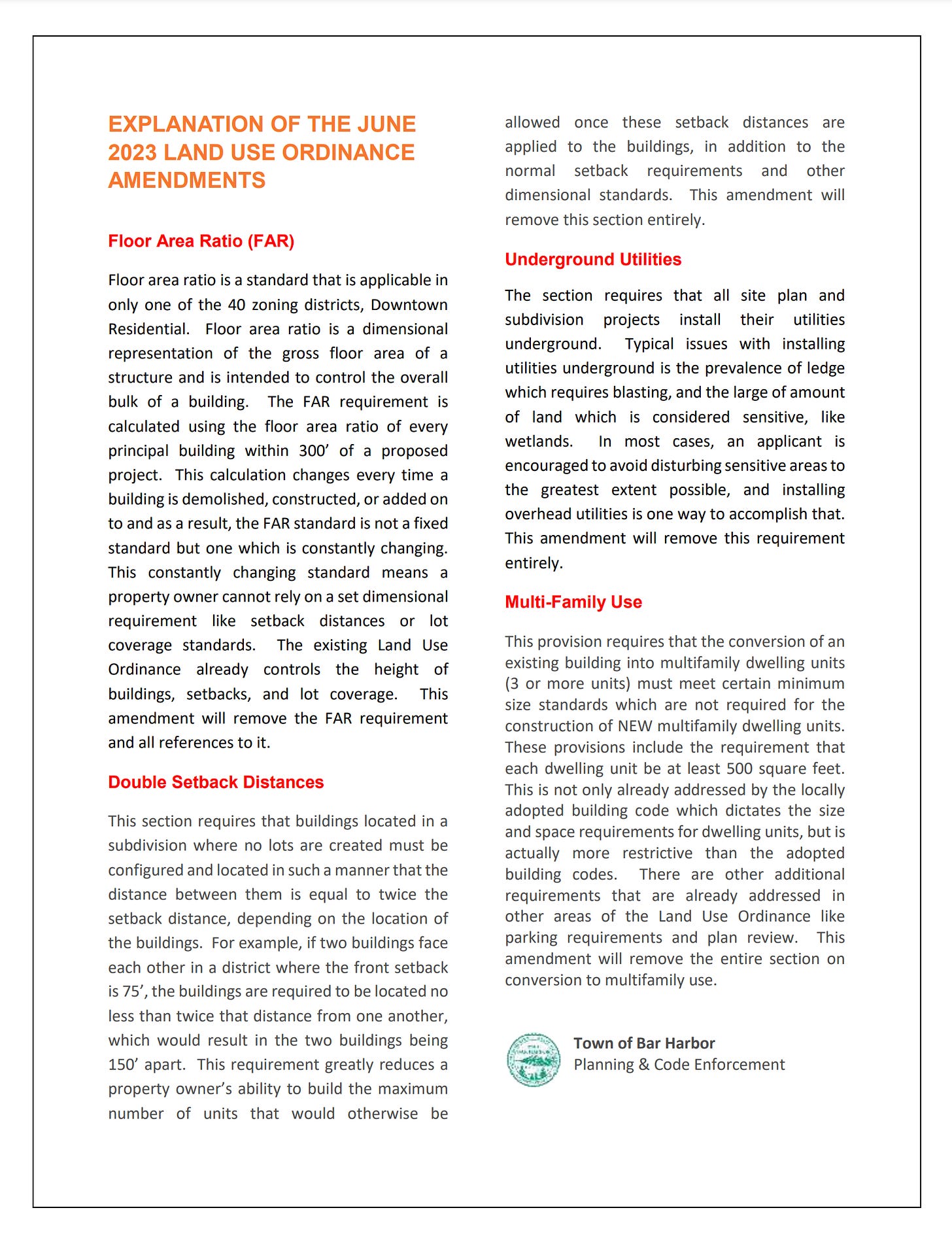Bar Harbor Could Implement Overlay District to Adapt to New State Rules Concerning Affordable Housing
Planning Board and Town Staff Shift Through 29 Priorities About Bar Harbor Land Use
BAR HARBOR—The Bar Harbor Planning Board held a workshop with Town Planning Director Michele Gagnon, Code Enforcement Officer Angela Chamberlain, and Deputy Code Enforcement Officer Michael Gurtler Wednesday, February 1, and reviewed the list of possible land use amendments, trying to determine priorities, talk about potential changes to what chapter things sit in, and more.
If it sounds vaguely complicated, that’s because it is. The land use ordinance is basically the rules for how land is used in a specific area such as a town, county. Bar Harbor’s land use ordinance contains zoning rules as well. It is Chapter 25 in the town’s code. Other chapters in the town code can usually be changed more easily. The chapter that is the land use ordinance has four ways that it can be amended.
All of the town’s code is publicly accessible on the town’s website.
On Tuesday, the board went through the priority list of 29 items for the land use ordinance amendments. Changes would require multiple steps before they are voted on by Bar Harbor residents either in June or in November. Four land use changes are set to go before the voters in June. There are no expected changes for that election. However, there may be some for the November election.
Complicated? Yes.
Important? Yes.
The land use amendment controls what can be built and how in Bar Harbor. It defines what a bed and breakfast is. It tells property owners how much they can build on their lot. It tells property owners what they can build on their lot. It also houses the new cruise ship disembarkation limits after the November election.
STRATEGIC PLAN AND HOUSE LEGISLATION LD2003
Gagnon linked the discussion of the priority list with the town’s strategic plan.
“The purpose of the strategic plan is to make sure that we look into the future,” Gagnon, said rather than just being busy and reacting as issues pop up. The strategic plan’s creation involved numerous committees, meetings, and boards. “There’s only so many hours in a week that you get to actually work on anything that’s not communication and that type of thing.”
One of the priorities in the list links the town’s strategic plan to LD 2003, which was passed in the state legislature and signed into law last April. It went into effect in July, 2022. Its requirements, however, don’t take effect until July 1, 2023. That means that the state law goes into effect July 1 barring any amendments or obstructions.
The act’s goals read:
Bar Harbor is considered a census-designated place.
Gagnon is going to propose that the town incorporates the LD2003 as an overlay district. “We would hope to have this in the ordinance at the latest as November 2023.”
An overlay district is often layered over one or more base districts, and it usually introduces an additional standard to development in that area.
Simple changes become a domino effect, Gagnon said. “When you run through changes, everything takes an inordinate amount of time.”
The state’s website says that the following actions are what municipalities can do via an interim guidance document and also below:
DESIGN REVIEW BOARD
A few of the priorities involved the town’s Design Review Board section of the land use ordinance (125-111). It’s all embedded within the land use ordinance, but the town staff hopes to set them up the way the Planning Board and Appeals Board are set up within the town code, rather than the land use ordinance which allows them to have a bit more flexibility and common sense application, Gagnon said.
Another change staff suggested is that they’d like to provide more than seven days between an application deadline and the Design Review Board meeting.
Staff also thought that some of the design review standards might need to be reworked for the review of new buildings. For instance, when the board compares the building to surrounding buildings and those buildings have lesser character, they wondered why compare the new building to those. How do you preserve the past while also moving into the present when designing building exteriors becomes the question.
There was also discussion about including all the properties on the National Register of Historic Places to appendix A. There was discussion about whether the Design Review Board should have mandated purview over all those structures. There are about 22 properties in Bar Harbor that are listed on that register, including the “West Street Historic District.” Being on the national register doesn’t make property owners beholden to standards unless they apply for state or local funds.
Planning Board member Joe Cough didn’t think the planning board should be involved with appendix A for the annual update. This is currently mandated via ordinance. Appendix A goes through the planning board to get on the town warrant.
HOUSING PROGRAMS AND ZONING
One priority is to create an inclusionary housing program and zoning.
The town decided to conduct a housing needs assessment to get numbers of what our housing needs are, Gagnon said. Inclusionary in this case would be a program that requires that a purpose of new development be maintained for incorporating lower income people.
The housing needs assessment predicts that the town requires 600 units by 2028, and said that many of those units should be long-term rentals to be inclusive and to keep workers. The economy may be effected if people are forced to commute, Gagnon said.
The success of inclusionary housing programs depends on what the program looks like, Gagnon said. A voluntary program that is so attractive that developers want to get into it is her goal.
Similarly, one of the priorities is considering expanding the number of districts where employee living (ELF) and shared accommodation are allowed and consolidating transient uses.
There are multiple definitions of transient accommodations and many of them have different parking standards. The hope is to condense them from 16 different types and rules to something more palatable and uniform. Gagnon said that it can be streamlined to something more simple, and though it looks simple, it becomes a massive job.
There are currently eight types of transient accommodations, five types of bed and breakfasts, and then hotels, motels, and cabins.
Currently, the ordinance says that if you are any of the transient accommodations, shared accommodations, or new bed and breakfasts then you have to go before the design review board. There are no standards for the board to apply for people who change their buildings’ use, but have no modifications to the outside of the building. Design Review Board, however, is only about the external aspects of the building.
Other priorities mentioned in the meeting included taking shoreland zoning provisions out of the land use ordinance and make it its own chapter of the code and adding parking standards for all transient accommodations.
Some are already underway. Gagnon and Chamberlain brought three other changes, and Brechlin suggested another to the Planning Board and the Town Council. Those changes, in the image below, are set to go before the voters at the June 2023 town meeting.
FARM EMPLOYEE HOUSING
Prior to the discussion and during public comment, Glenon Friedmann, representing Bar Harbor Farm at 115 Gilbert Farm Road in the Town Hill Rural district, said that one of the farm’s biggest challenges is employee housing. They originally had a plan that had a few cabins for workers. They couldn’t build the cabins and get a permit because it wasn’t an allowed use in that district. She asked that farm employee housing be added as an allowed use in the zone.
Gagnon said that the planning staff has been talking about expanding the district where that was allowed. Or a similar use could potentially be added to the Town Hill Rural district.
“Employee housing is needed for more than restaurants and downtown shops,” she said.
LINKS TO LEARN MORE
Click here to see SMPDC's online map
https://www.barharbormaine.gov/AgendaCenter/ViewFile/Agenda/_02012023-3137
https://www.barharbormaine.gov/282/Planning-Board
https://www.canr.msu.edu/news/overlay_zoning_districts_can_be_a_valuable_tool













Sloppy language and lazy thinking at best or bias in favor of fast buck real estate developers and cronyism at worst, have allowed a 45 room hotel to be classified as a B&B. Every time I walk past the site, I think 'this should be used for affordable housing.' In fact, so could many of the sites used for seasonal t-shirt shops etc catering to the cruise ship trade. In-fill multi unit housing projects would lead to a more livable community and economically viable downtown, while preserving green space from suburban development. Eco-Eco.